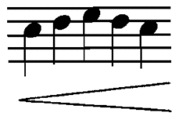Difference between revisions of "Crescendo"
(Created page with 'File:lighterstill.jpgright|frame ==Origin== Italian, from ''crescendo'', adjective, increasing, gerund of ''crescere'' to grow, increase, from [[L...') |
m (Text replacement - "http://" to "https://") |
||
| Line 3: | Line 3: | ||
==Origin== | ==Origin== | ||
Italian, from ''crescendo'', adjective, increasing, gerund of ''crescere'' to [[grow]], increase, from [[Latin]] | Italian, from ''crescendo'', adjective, increasing, gerund of ''crescere'' to [[grow]], increase, from [[Latin]] | ||
| − | *[ | + | *[https://en.wikipedia.org/wiki/18th_century 1775] |
==Definitions== | ==Definitions== | ||
*1a : a [[gradual]] increase; specifically : a gradual increase in [[volume]] of a [[musical]] passage | *1a : a [[gradual]] increase; specifically : a gradual increase in [[volume]] of a [[musical]] passage | ||
| Line 13: | Line 13: | ||
[[File:Cresendo_w-hairpins.jpg|center|frame]] | [[File:Cresendo_w-hairpins.jpg|center|frame]] | ||
| − | Hairpins are usually written below the [ | + | Hairpins are usually written below the [https://en.wikipedia.org/wiki/Staff_(music) staff], but are sometimes found above, especially in music for [[singers]] or in music with multiple [[melody]] lines being played by a single performer. They tend to be used for [[dynamic]] changes over a relatively short space of time, while ''cresc''., ''decresc''. and ''dim''. are generally used for dynamic changes over a longer period. For long stretches, dashes are used to extend the words so that it is clear over what time the [[event]] should occur. It is not [[necessary]] to draw dynamic marks over more than a few bars, whereas [[word]] directions can remain in [[force]] for pages if [[necessary]]. |
For greater changes in dynamics, ''cresc''. ''molto'' and ''dim. molto'' are often used, where the ''molto'' means much. Similarly, for slow changes ''cresc''. ''poco a poco'' and ''dim. poco a poco'' are used, where ''poco a poco'' [[translates]] as little by little. | For greater changes in dynamics, ''cresc''. ''molto'' and ''dim. molto'' are often used, where the ''molto'' means much. Similarly, for slow changes ''cresc''. ''poco a poco'' and ''dim. poco a poco'' are used, where ''poco a poco'' [[translates]] as little by little. | ||
[[Category: Music]] | [[Category: Music]] | ||
Latest revision as of 23:42, 12 December 2020
Origin
Italian, from crescendo, adjective, increasing, gerund of crescere to grow, increase, from Latin
Definitions
- b : the peak of a gradual increase : climax <complaints about stifling smog conditions reach a crescendo — Down Beat>
- 2: a crescendo musical passage
Description
Two Italian words are used to show gradual changes in volume. Crescendo, abbreviated cresc., translates as "gradually becoming louder", and diminuendo, abbreviated dim., means "gradually becoming softer". The alternate decrescendo, abbreviated to decresc., also means "gradually becoming softer". Signs sometimes referred to as "hairpins" are also used to stand for these words (See image). If the lines are joined at the left, then the indication is to get louder; if they join at the right, the indication is to get softer. The following notation indicates music starting moderately loud, then becoming gradually louder and then gradually quieter:
Hairpins are usually written below the staff, but are sometimes found above, especially in music for singers or in music with multiple melody lines being played by a single performer. They tend to be used for dynamic changes over a relatively short space of time, while cresc., decresc. and dim. are generally used for dynamic changes over a longer period. For long stretches, dashes are used to extend the words so that it is clear over what time the event should occur. It is not necessary to draw dynamic marks over more than a few bars, whereas word directions can remain in force for pages if necessary.
For greater changes in dynamics, cresc. molto and dim. molto are often used, where the molto means much. Similarly, for slow changes cresc. poco a poco and dim. poco a poco are used, where poco a poco translates as little by little.

